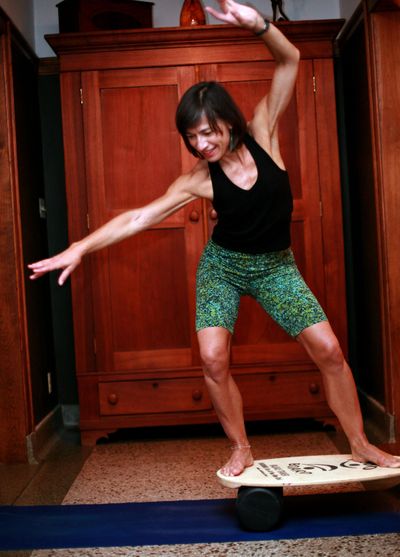Stability tools help with balance training

Balance is such a fundamental part of each movement that it hurts – sometimes literally – when it’s gone. But to strengthen our balance, especially as we age, it turns out we do need to lose it. Or at least test it a little.
Kids do this naturally by walking, running on or scrambling up the most precarious surfaces they can find. Adults might be better off trying balance training, which can involve using unstable equipment, such as BOSU balance trainers, wobble boards, rockers and stability disks.
More than 90 percent of personal trainers now incorporate balance training tools, according to an industry survey. But teetering on unstable surfaces isn’t just fun and different. It forces you to activate the smaller, stabilizing muscles in knees, ankles and hips that don’t necessarily get a workout when you’re on solid ground.
For older adults, balance training can help reduce the risk of falls and shattered bones. It’s also used for rehabilitation and to help children with sensory integration or attention-deficit disorders.
Still, while balance training has a place, it’s often overused, said Jay Dawes, education director for the National Strength and Conditioning Association. “When picking a training program, think about how it will transfer to your daily life,” stressed Dawes. If you’re not a circus performer or Olympic skier, the benefits might not be as great as you think, Dawes said.
To add some healthy instability to your life, stand on one leg for 30 seconds and close your eyes. Or, step on one of the following boards and try to keep the edges from touching the ground. Start with 15 to 30 seconds, two to three times a week, and work your way up to 30 seconds to a minute.
Rocker boards. A good introduction to basic balance training, rocker boards have a base that tilts forward and back or side to side. Used by hockey players and skiers, they can also help children who suffer from conditions such as traumatic brain injury, sensory integration disorders and low muscle tone, said Erin Luy, an occupational therapist at Marianjoy Rehabilitation Hospital in Wheaton.
Get it: Square Rocker Board $49.95, SPRI Products spri.com.
Wobble boards. A wooden or plastic board that teeters in all directions, they’re often used for prehabilitation and to help increase stability, agility and mobility. Personal trainer Cathy Leman of Elmhurst, Ill., used one to treat a severe case of plantar fasciitis on both feet. “Agony, but helpful,” she said. Can be used for push-ups, sit-ups, one-legged standing. Some boards can be adjusted to be both wobbles and rockers.
Get it: Pro Wobble Board, $79.95, fitter1.com.
Indo board. Remember the Bongo Board? Indo Boards are similar, with wide, skateboard-like platforms set on a hollow plastic roller. Fun, addictive and loved by both preschoolers and the U.S. Ski and Snowboarding Association, Indo Board rollers can turn into missiles if you’re not careful. The IndoFLO cushion can slow things down, but it’s best to use this on grass or carpet and allow some space. I would not put my 72-year-old mother on this one.
Get it: Indo Original, $99.95, indoboard.com.
Bosu balance trainer. These popular flat-bottomed stability balls work for a range of ages and abilities. Use them for push-ups, squats, lunges and more cardiovascular exercises such as toe taps or jumps, said Alex Mueller, a personal trainer and manager of Fitness Together in Lake Forest, Ill. Try lying on the floor, placing both feet on the platform side and lifting your hips off the floor. Or use it as a modified bench by lying on the platform side while performing upper body exercises. Just don’t stand on it when it’s dome-side down.
Get it: Bosu Home Balance Trainer $99.95, bosu.com.
Balance disc. Air-filled discs that resemble giant whoopie cushions; the more air, the greater the balancing challenge. Try a push-up with one small disc under each hand. Or put a thin one on your office chair to subtly activate core muscles, said Leman, who sits on an Exerdisc. Larger discs can be used for core exercises while standing, sitting, kneeling or lying down. You can also use it like a BOSU for push-ups, squats, lunges and torso stabilization.
Get it: Xerdisc, $24.95, spri.com.